Davyhulme WwTW Modernisation Project (2019)
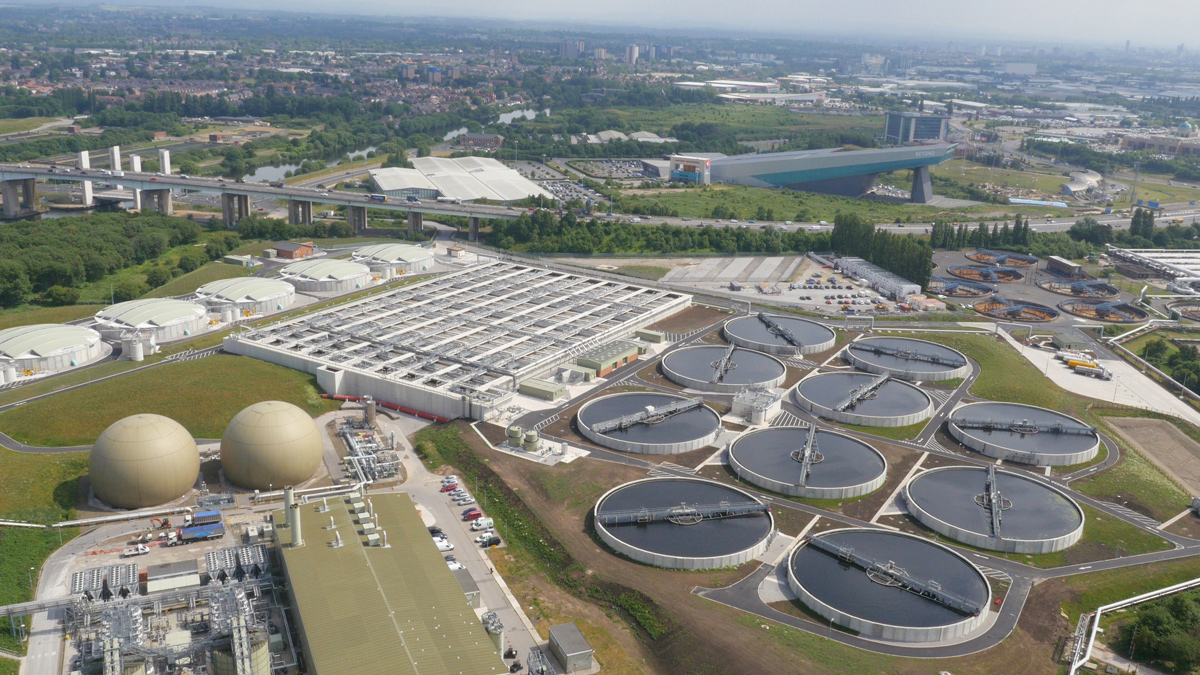
Davyhulme WwTW - Courtesy of Webb Aviation
Davyhulme Wastewater Treatment Works (WwTW) is United Utilities (UU) largest, serving over 1.3 million customers across Greater Manchester. Built in 1894, it has seen continuous development in wastewater treatment including the invention of the activated sludge process (ASP) by Ardern & Lockett in 1914. Incoming flows from the combined sewer network can reach 30m3/s, the flow to full treatment is 8.36m3/s. The existing wastewater treatment facilities basically comprised two similar activated sludge treatment streams with aeration provided via surface aerators; ASP1 (treating 40% of inflows) and ASP2 (treating 60% of inflows). The Davyhulme Modernisation Project (DMP) was the largest wastewater project awarded during AMP6 (2015-2020), delivered by a team of approximately 400 people.
This article follows on from case studies in 2016 and 2017 detailing the earlier stages of the modernisation project:
Project drivers
The reasons for this significant investment are as follows:
- A Flow 4 Driver that stipulates a requirement to measure and record the flows entering the works at the inlet, together with accounting for the various other internal returns. Existing regulatory flow measurement apparatus measured flows at the discharge end of the WwTW.
- Achieving compliance with a more stringent final effluent ammonia (NH3) discharge consent of 1 mg/l, compared with an existing consent of 3 mg/l. This is driven by Davyhulme’s inclusion in the National Environment Programme (NEP) as a result of the receiving Manchester Ship Canal (MSC) being designated under the Freshwater Fish Directive in 2003. This revised consent will also meet the requirements of the Water Framework Directive.
- Meeting the demand of exponential population growth (within Manchester) until 2035 alongside the impact of climate change. Davyhulme WwTW had a population equivalent (PE) of 1,030,591 in 2012 and has a forecast future (PE) of 1,301,230 for the 2035 design horizon.
- Resolving inefficiencies from outdated assets; Davyhulme now generates enough renewable energy to power the plant and put energy back into the grid.
The above drivers equate to 2.43km of Rivers Improved and 125.5km of Rivers Protected from population growth.
Undertakings
The Davyhulme Modernisation Project was procured as a design, build and commission contract between UU and Laing O’Rourke (LOR), which was awarded January 2015.
The £187m was invested into the following:
- Activated sludge plant (ASP) including:
- 6 (No.) 41m diameter primary settlement tanks (PSTs).
- Ten-lane ASP (175m x 110m x 8m deep).
- 10 (No.) 46m diameter final settlement tanks (FSTs).
- New secondary activated sludge (SAS) thickening plant.
- A new inlet works and refurbishment of existing assets.
- De-commissioning of existing ASP1 process stream.
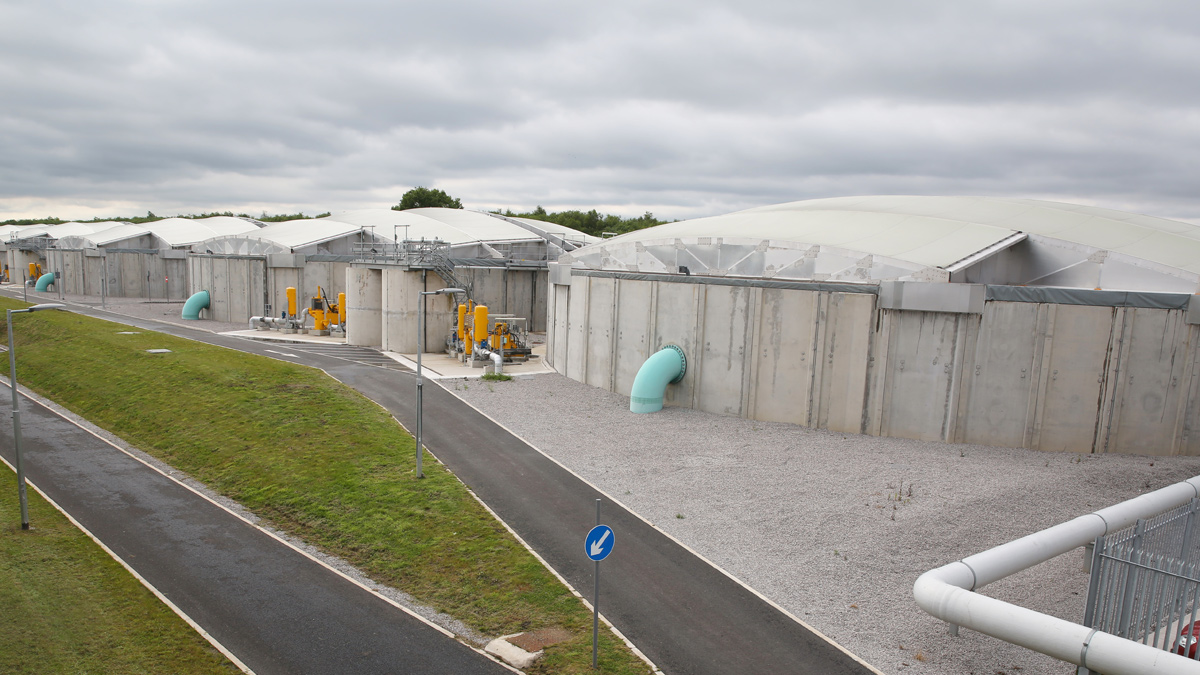
Primary settlement tank arrangement – Courtesy of United Utilities
The new works
New inlet channels direct flows for full treatment through coarse (40mm) screens upstream of new fine (6mm) screens. Flows are then lifted via a refurbished screw pumping station before passing through 4 (No.) refurbished detritors to remove grit.
After passing through a fats, oil and grease (FOG) recovery process, 40% of flows gravitate through to ASP2 and the BAFF, whilst 60% are pumped via a new pumping station to the 6 (No.) new ASP3 PSTs. Return activated sludge (RAS) and influent from the PSTs are mixed via a static mixer designed using computational fluid dynamics (CFD).
Flows then pass through a common anoxic zone prior to two ‘swing zones’ that can be either anoxic mixing zones or an extension of the aeration lanes, according to the instantaneous flows/loads. Aeration is achieved in the new activated sludge (ASP3) plant via fine bubble diffused air (FBDA) with 40 (No.) dissolved oxygen probe sets (one in each of the four zones within each of the ten aeration lanes).
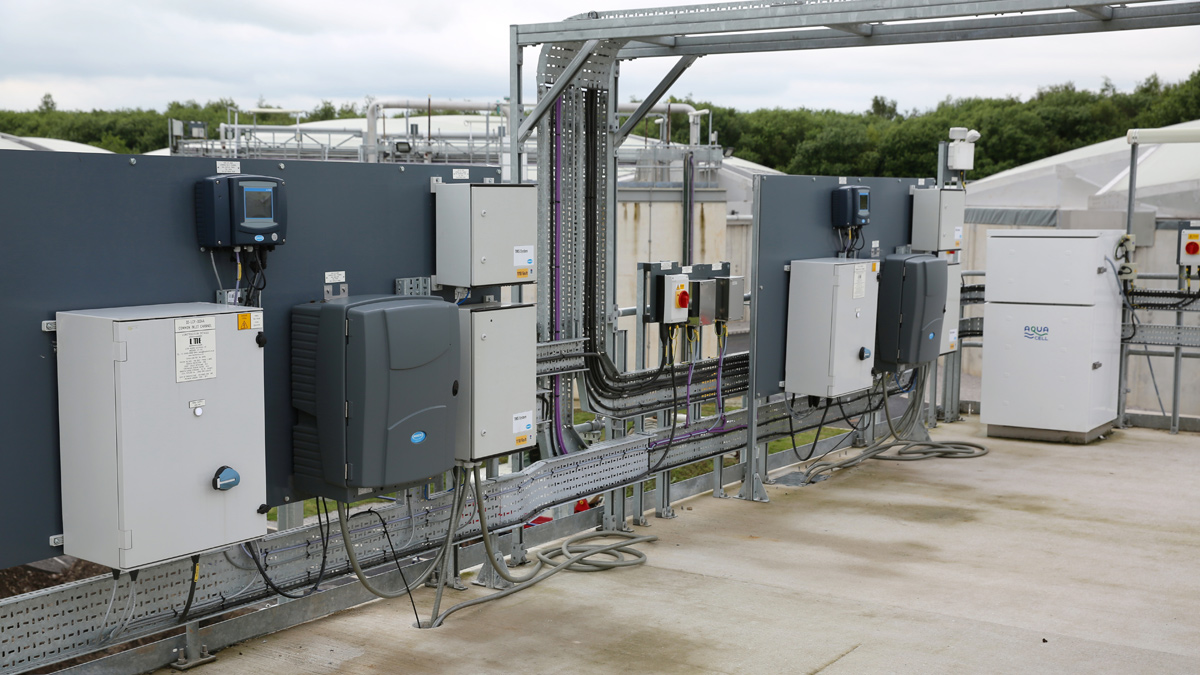
Ammonia instrumentation panels at the inlet to ASP3 aeration tank – Courtesy of United Utilities
There are also ammonia level monitoring instruments at the inlet and outlet of the aeration lanes that input into the control software to meet the 1 mg/l NH3 consent without the need for tertiary treatment. Air is delivered to ASP3 via 6 (No.) duty and one standby blowers with 40 (No.) modulating air control valves upstream of the air diffuser grids at the base of the 9m deep tank.
A major upgrade to the power distribution at the Davyhulme site was necessary to serve the new process stream. Upgrading the existing system control and data acquisition (SCADA) arrangement to a distributed control system (DSC) across the site that aligned with control systems adopted by the adjacent Manchester Bio-Resource Centre was a significant piece of work.
The new assets now take 60% of the works flow, improving performance and resulting in significant power and chemical consumption savings. Commissioning of the new plant included one month of ‘Performance and Reliability Tests’ followed by a further set of ‘Performance and Optimisation Tests’ to ensure that the plant performed efficiently and within the contractual process quality and economic guarantees.
With space at a premium, DMP was built on land historically used to stockpile waste; this land was remediated. A comprehensive materials strategy resulted in the majority of the 200,000m3 of earthworks reused, minimising off-site movements. The new entrance was constructed first to move traffic away from the existing site entrance, close to a housing estate, minimising operational interruptions.
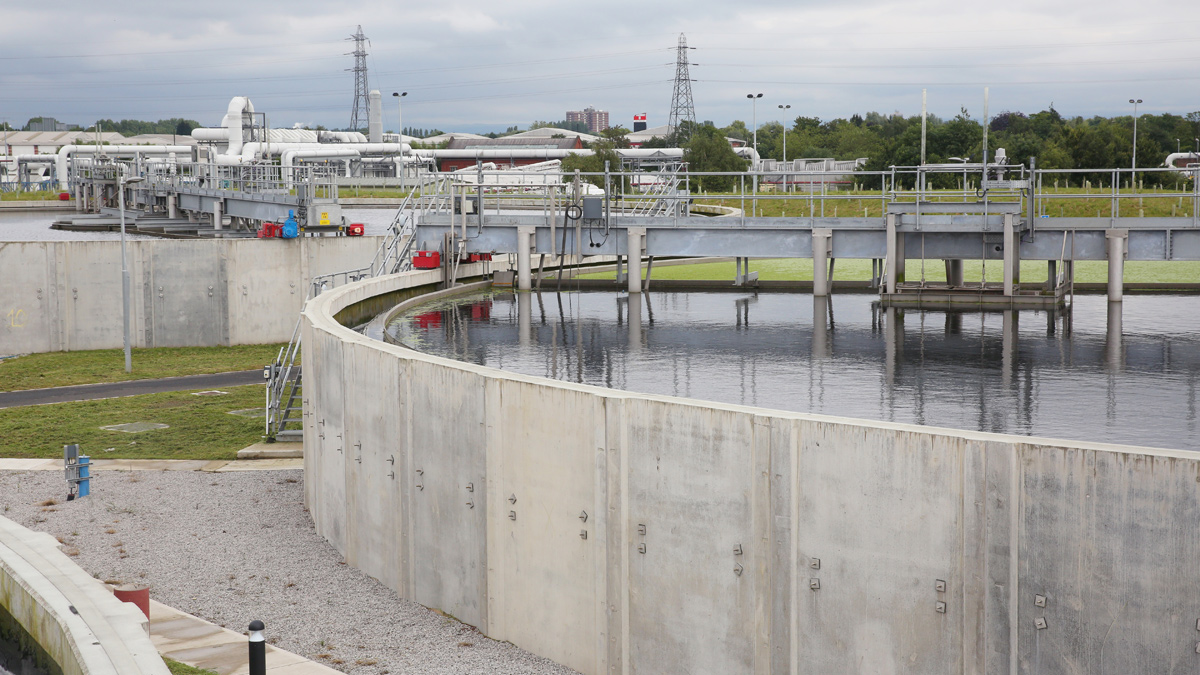
Final settlement tanks – Courtesy of United Utilities
BIM
Providing a 4D visualisation though BIM (Building Information Modelling) was integral to the success of DMP. The 4D model combined civil, mechanical, electrical, instrumentation and supplier models into a single reference point. The 4D visualisation meant each construction activity was reviewed with stakeholders to ensure constraints were mitigated. It provided a representation of changes and highlighted problems before they physically occurred on site.
DfMA
The use of Design for Manufacture and Assembly (DfMA) was identified as a key efficiency strategy. The use of precast elements and off-site manufacture provides significant benefits for site safety, time and cost compared to traditional on site construction. Particular care is required during the design, manufacture and installation of precast units where there is an interface with mechanical equipment, for instance, where mechanical bridge drive wheels bear onto the copings of FST perimeter tank walls.
The three main structures, the primary settlement tanks, activated sludge plant and final settlement tanks, were all built from precast concrete units; each 4D modelled in detail. This additional effort during the design stage mitigated the risk of clashes during construction. To ease congestion and increase construction efficiency within the ASP lanes, tower cranes were installed on rails. Mechanical equipment in modular form was also pre-assembled off-site including pipework, steelwork, walkways and platforms. Working closely with our supply chain, 14 (No.) new motor control centres (MCC) were also pre-assembled off-site. Each MCC was installed on a base within 15 minutes versus the traditional method taking 14 days.
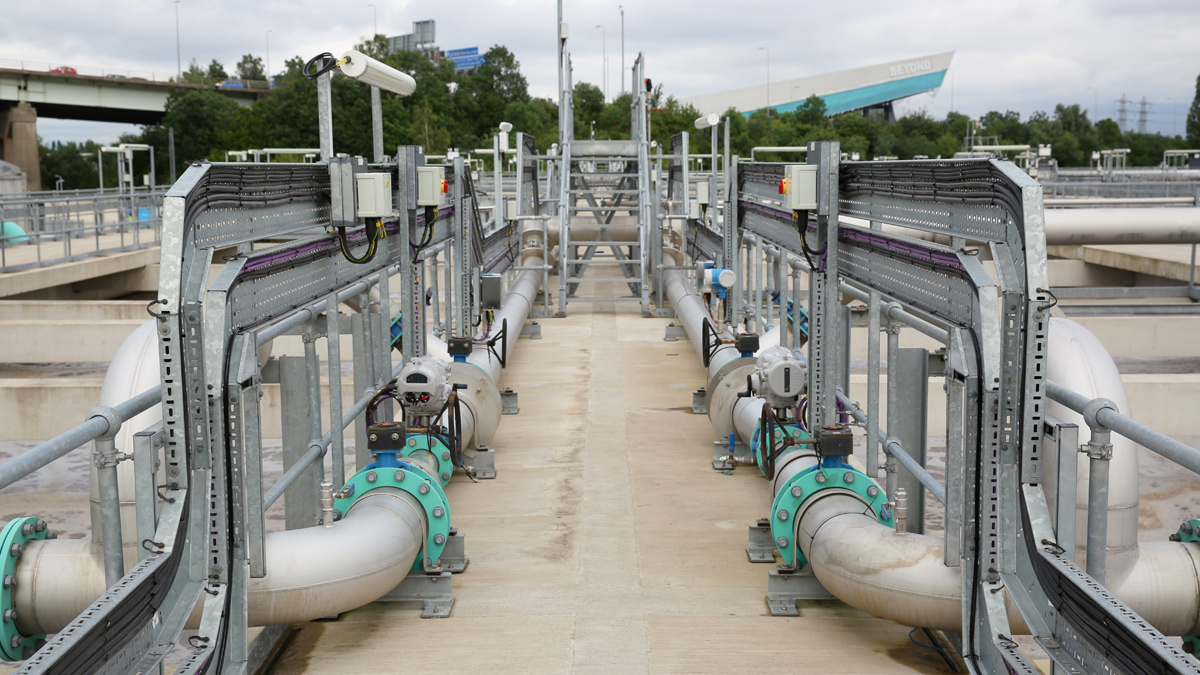
Typical air delivery pipework and control valve arrangement – Courtesy of United Utilities
Health & safety
The DFMA approach has saved 6,800 on-site working days, generated significant savings and reduced H&S risks.
The DMP approach to H&S is personal commitment and individual empowerment. United Utilities believe that “everyone has the right to return home safely every day” and that “Nothing we do is worth getting hurt for”. This approach contributed to a positive health and safety culture; over 1,500,000 hours without a RIDDOR incident.
Ecological improvements
DMP has made ecological improvements to the land adjacent to the site. Existing wildlife habitats in Davyhulme Millennium Nature Reserve have been improved and new links created extending wildlife habitats and encouraging biodiversity.
Completion
UU committed to deliver DMP before April 2018. The new assets accepted first flows via the Inlet works in September 2017 and the ASP in December 2017 – four months ahead of the deadline. The sludge treatment plant was also delivered 12 months early in May 2017, maximising the renewable energy output.
The project has been delivered within budget. The benefits delivered to customers include: water quality improvement in the MSC, redirecting traffic away from residential areas, landscaping that minimises the visual impact of the WwTW and managing odour emissions.
DMP delivered on its promise to provide a robust, innovative treatment process, protecting the environment for years to come. The new processes passed tests and remains fully environmentally compliant. Data shows the new assets are delivering the required benefits along with further operational savings.
UU and LOR ensured sustainability with £50m of investment going to local businesses, generating 26 new construction jobs, supporting 35 apprenticeships, working with more than 2,000 local students and supporting initiatives for unemployed. £100,000 was donated to 20 local registered charities and 45 local community groups benefited from 749 hours volunteer time.
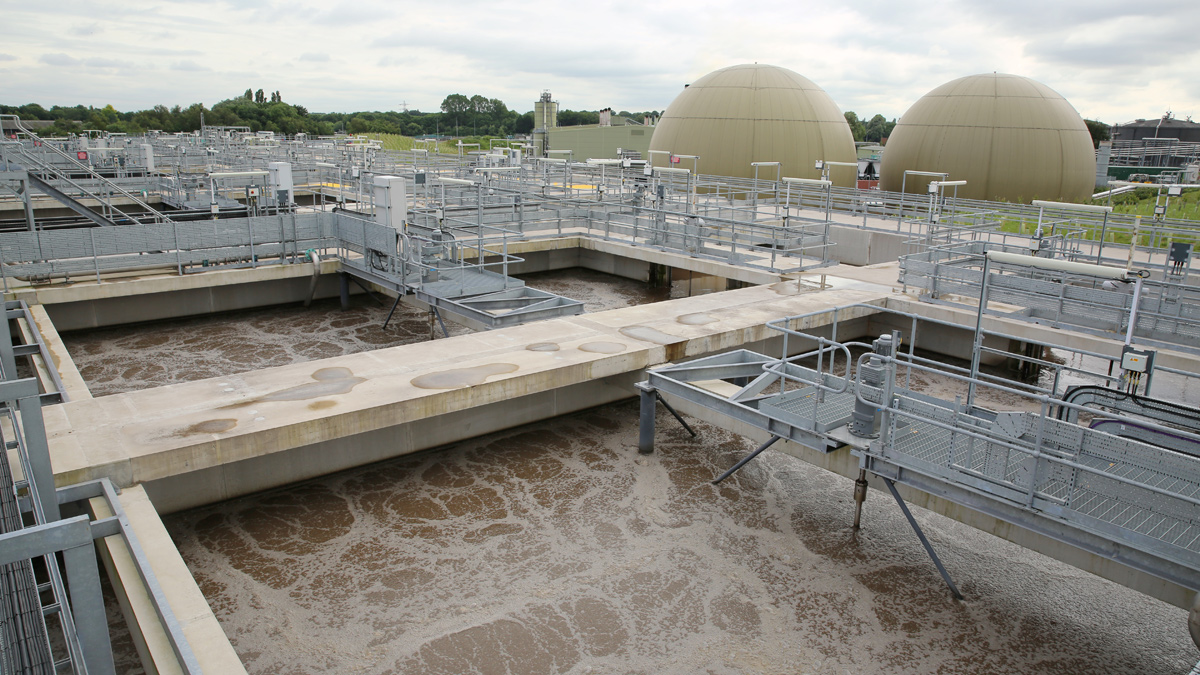
Swing zone in lanes 1 and 2 operating in aeration mode – Courtesy of United Utilities
Accolades and awards
DMP received accolades from Trafford Clinical Commissioning Group, Considerate Constructors, customer service WOW Award and high profile visits from the European Investment Bank and Kate Green MP. PP O’Connor (a local business located 6 miles from Davyhulme that delivered over £20m of civil work) and Laing O’Rourke won the Collaborative Partnership award at the Civil Engineering Contractors Association.
The Davyhulme Modernisation Projects won the Institution of Civil Engineers North West Area Major Project Award in 2019.




















